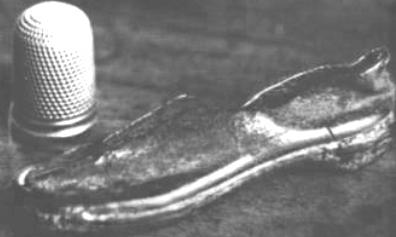Editor’s Note: Here are three account of what may conceivably be the same fairy relic, though we are speaking about different parts of Ireland. See also The Little Shoe.
Crofton Croker wrote (84, 1824): A paragraph recently appeared in a Kilkenny paper stating, that a labourer, returning home in the dusk of the evening, discovered a Leprehaune at work, from whom he bore away the shoe which he was mending; as a proof of the veracity of his story it was further stated, that the shoe lay for the inspection of the curious at the newspaper office. The most prominent feature in the vulgar creed.
Are you aware that, on this side of the channel [i.e in Ireland], we have so little doubt of the existence of fairies, that it is no uncommon occurrence to see shoes of fairy manufacture publicly advertised in the newspapers? If I tell you, that while crossing a field, in the purple light of the morning, the attention of a peasant was arrested by the sound of a shoemaker’s hammer; and that, upon leaving the path to discover the cause, he disturbed an elfin cobbler, who it seems was at his trade betimes, and mending his brogues by the side of the ditch; that the spirit of the air, anxious to escape from the prying eyes of mortal wight, leapt from the bank, and, in his haste, dropped both shoe and hammer: if I go on to tell you, that this story is most gravely related, and that the editor informs the public, that both shoe and hammer were carried to such a house, in such a street, in a certain town, in the county of Roscommon, and may there be viewed by any curious or incredulous persons; you will, I think, acknowledge that my tale has at least a better foundation than many which are related to our disadvantage, and but too readily swallowed by the credulity of our English friends (Blake 1825 118-119).
It was found by a farm labourer on the Beara Peninsula, south-west Ireland, in 1835. It is black, worn at the heel and styled like that of an eighteenth-century gentleman. But it is also only two and seven-eights inches long and seven-eights of an inch at its widest – too long and narrow even for a doll’s shoe. If it were an apprentice piece, say, how did it come to be found on a remote sheep track? Why was it made in the style of the previous century? Why is it such an odd shape? How did it come to be worn?… The man who found the shoe assumed it belonged to the ‘little people’ and gave it to the local doctor, from whom it passed to the Sommerville family of Castletownshend, County Cork. On a lecture tour of America, the author Dr. Edith Sommerville. gave the shoe to Harvard University scientists, who examined it minutely. The shoe had tiny hand-stitches and well-crafted eyelets (but no laces), and ‘was thought to be’ of mouse skin (Harpur 134-135).


